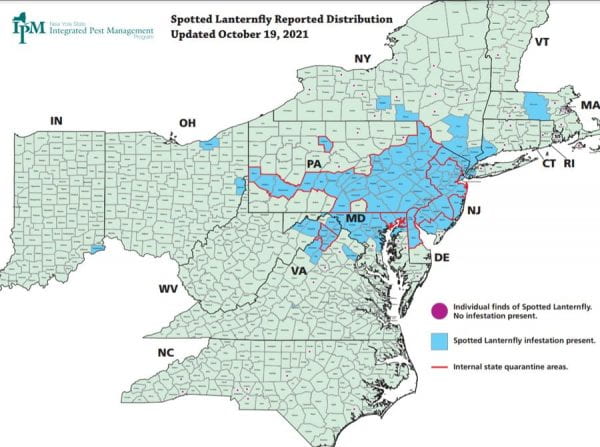Despite significant changes to the timing and schedule of Ohio Maple Days not to mention the ever-evolving challenges presented by COVID, we had a great turnout in Ashland back on December 11th. A subset of maple producers, about 20 in number, also enjoyed an excellent syrup grading workshop on Friday night the 10th.
During the morning session, Amy Stone (an Extension educator from Lucas County) presented on spotted lanternfly and was kind enough to share her graphic-heavy slide deck with us. You might consider this a Part I post and I’ll follow-up with a Part II next week.
This half is all about spotted lanternfly. What do they look like, where did they come from, where are they now, where might they be going, why you should care about them, and most importantly – how to report spotted lanternfly if you do spot them. Click here to access Amy’s whole slide deck from her presentation on 12/11/2021.
Spotted Lanternfly (Amy Stone) Slide Deck from Ohio Maple Days December 2021
An infestation of adult spotted lanternflies is pretty hard to miss or mistake for something else.
The adults are preceded by 4 instars of developing maturity. Each stage has a diagnostic “look” and the season when they are active. Familiarizing oneself with the life cycle and knowing how spotted lanternfly will manifest depending on the time of year is key for solid monitoring.
At first glance you may only notice the one egg mass but look up and you’ll see a second. Egg masses immediately after a female lays is fairly easy to see, but with passing time, the shiny coat over the egg mass fades and the mass become far more cryptic and camouflaged.
Spotted lanternfly was first detected in Jefferson County, OH, but recently Cuyahoga County has been added to the list of known OH positives.
For a comprehensive dive into spotted lanternfly, dig through the slide deck. It’s a great exploration of this novel invasive forest pest.
Part II next week will focus on some specific preliminary findings on how spotted lanternfly are believed to be impacting maples. Because of where spotted lanternfly infestations are currently heaviest, most of the results are from Pennsylvania and most applicable to red and silver maples, but you’ll want to tune back in to hear what some researchers – including several from Penn State University – are starting to learn about the maple – spotted lanternfly interaction.
If you see spotted lanternfly or other invasive species, please report your findings! That is the single best way to improve the efficiency of any efforts to fight back. Click here for more information on reporting through the Great Lakes Early Detection Network (GLEDN).




